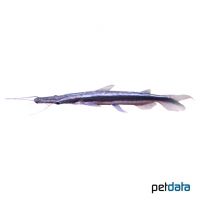Duckbill Catfish (Sorubim lima)
| Duckbill Catfish Sorubim lima | |
|---|---|
| Name | Duckbill Catfish |
| Name Lat. | Sorubim lima |
| Family | Long-whiskered Catfishes |
| Family lat. | Pimelodidae |
| Order | Catfishes |
| Order lat. | Siluriformes |
| Origin | South America |
| Habitat | Rivers, floodplains |
| Diet | Carnivore |
| pH | 6.0-7.5 |
| Behavior | Nocturnal, predatory |
| Keeping | Individual, group |
| Care Level | Difficult |
| Reproduction | Oviparous |
| Breeding | None reported |
| Life Span | 8-10 years |
| Protection | No |
| Metric Units | |
| Size | 40-50 cm |
| Temperature | 22-30 °C |
| Hardness | 5-15 °dH |
| Aquarium | ~ 1.000 l |
| US Units | |
| Size | 16"-20" |
| Temperature | 72-86 °F |
| Hardness | 89-267 ppm |
| Aquarium | ~ 260 gal |
Distribution and habitat
The mainly nocturnal spade catfishes are widespread in the large rivers, such as the Amazon, Orinoco, Parana, Parnaiba and Tocantins, as well as in their tributaries. They reside in open, flowing water, but also in still water and floodplains. Juveniles often form large schools in reeds, under roots and dead wood.
Maintenance
The aquarium should have a robust border planting, with many hiding places like stone caves (e.g. perforated rock) and roots as well as free swimming space. A sandy substrate, some subdued light (floating plants) and a weak current is ideal. No ammonia, ammonium and nitrite should be detectable in the water, the nitrate value should not exceed 100 mg/l. To ensure water quality and oxygen content, a filter and heater adapted to the aquarium size is required, as well as lighting for the species-appropriate day-night rhythm of the animals.
Diet
In nature they feed mainly on fish, crustaceans and invertebrates. The diet for juveniles consists of live or frozen mosquito larvae, tubifex, earthworms and shrimp, for adults whole mussels, cockles, shrimp, smelts and chopped squid. The food changeover succeeds without problems after a short acclimation.
Only as much should be fed as is eaten immediately (in a maximum of 10 minutes). Adult animals should be fed only 1-2 times per week. Regular and varied feeding promotes health and increases resistance.
Behaviour and compatibility
They are peaceful fish that can be kept in a group without any problems. However, they will eat anything that fits in their mouths and therefore can only be socialized with appropriately sized fish
Basically, only compatible fish species with similar demands on water conditions and water temperature may be socialized.
Sex dimorphism
There are no known external distinguishing characteristics.
Reproduction and breeding
There are no known reports of successful breeding in the aquarium.
Important
The contrasting juvenile coloration fades with age. Juveniles in particular often swim vertically, head down and caudal fin up, to camouflage and hide among plant leaves, reeds and roots.
Spatulate catfish should not be fed beef heart or chicken meat, as it cannot be digested and leads to fat deposits and organ damage
When trapping, use the finest mesh nets possible to avoid snagging the hard rays of the pectoral fins, which can cause painful puncture wounds when touched.
The well-being of the fish should be checked regularly. Temperature should be checked daily, pH, hardness and nitrate levels should be checked at least every 14 days. Regular partial water changes are recommended, even when contaminant levels have not yet reached the upper limit. Sudden changes in water quality should be avoided. Newly introduced fish must be accustomed slowly to the water in the aquarium.
Further literature can be found in your pet store.
References
Text: Werner Winter; Image: petdata
Source: BMEL (1998): Tierschutzgutachten - Haltung von Zierfischen (Süßwasser); RIEHL & BAENSCH (2006): Aquarien Atlas Bd. 1, Mergus Verlag; ENGELMANN (2005): Zootierhaltung - Tiere in menschlicher Obhut: Fische, Verlag Harri Deutsch
- Gemäß § 21 Abs. 5 Tierschutzgesetz idgF
